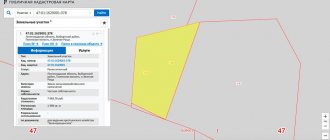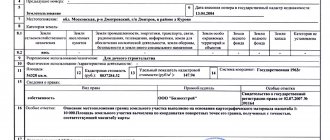Home » Land » Registration
- 1 Functions of the cadastre
- 2 Previously recorded area
- 3 Documentation
- 4 Installation at the GCU with land surveying
- 5 No boundary markings
- 6 Dacha amnesty
- 7 Stages
- 8 Timing and cost
- 9 Help
- 10 Suspension and withdrawal
If you own a piece of land, you cannot dispose of it until you register it with the cadastral register. To avoid territorial disputes from neighbors and gain the legal right to dispose of the property at your own discretion, you must know the rules for registering a land plot in the cadastral register.
Functions of the cadastre
Without registering land property in the cadastral register, you will not be able to obtain a certificate of state registration of ownership, and without it the owner cannot carry out subsequent legal transactions, these include: sale, lease and donation.
It is also necessary for the development of the site and communications on it. The Civil Code of Ukraine confirms legally the existence of a site on the territory of the Russian Federation and enters certain of its characteristics into the state register. registry. With the help of the cadastre, land is recorded to record rights to it, establish boundaries on the ground, and taxation.
Goals and objectives
The main task of the State Property Committee is to provide clear data and complete characteristics of all real estate objects for the civilian population, as well as assigning cadastral numbers to all land plots for further manipulations regarding real estate.
You should know: to determine the location of any object, the cadastral engineer must carry out a complete analysis of the building, structure or land plot and subsequently enter the coordinates of the turning points of the corresponding object into the State Property Committee database.
A special feature of the state real estate cadastre is the program of unified database maintenance throughout the Russian Federation, the progress of which consists in the continuous synchronization and updating of all information separately for each plot or property, as well as the prompt public availability and relevance of data for all citizens of the country in need.
The state cadastre maintenance system is required to fulfill such items as:
- recognizing as normative the location (non-location) of real estate items on the territory of the state;
- registration and supervision of the use of property and land, their protection;
- scheme and coordination of land use;
- analysis, assessment of real estate and establishment of appropriate tariffs for its operation;
- application of state registration standards for real estate, namely Rosreestr;
- physical protection and legal persons on the normativity of real estate items;
- availability of publicly available information about a set of actions regarding real estate;
- conducting taxation of registered lands and objects.
The main task of the state. Real estate cadastre - providing interested parties with the necessary materials about objects of registration.
From all of the above, the general purpose of this type of activity is shown - the correct exploitation of all lands and resources of the country. If you have complete information about the status of land plots and real estate, you can manage rationally and make the right decisions regarding their purpose.
Previously recorded area
A previously registered plot is an allotment for which the rights were registered before March 1, 2008, but the State Civil Code was not issued, or a plot that was already registered with the State Civil Code and has a cadastral passport, but its owner has changed. The boundaries of such territories do not have clear parameters; it can also be divided into several parts.
ATTENTION! In order to carry out a transaction for the sale/lease/donation of such territory or part of it, you need to put it on the State Civil Code.
Features of previously recorded land management objects:
- If the allotment has been previously taken into account, when placing it on the Civil Code there is no need to carry out work to clarify the boundaries. It is enough to attach the old cadastral plan, and carry out the cadastral work later.
- If the owner decides to remove a previously unregistered land management property from the register, he will have to go to court.
- The State Cadastre did not find information about the location of the plot.
- There is no information about characteristic points that can indicate its boundaries.
- The limits of the later-registered allotment intersect with the boundaries of the land that the owner currently wants to register.
To register real estate in the State Civil Code Chamber as a previously registered plot, the owner needs to apply there with a request to enter new data about the land and present documents for it. Next, the boundaries are clarified, and after 18 days you will receive a new certificate. The land can be supplied to the GCU by:
- Direct owner of the property;
- A tenant who has rented a plot for more than 5 years;
- Users of the territory (indefinite use of the plot, etc.);
- Citizens interested in registering land as a public utility (they can be state companies, government agencies, etc.).
Transition from land cadastre to real estate cadastre
In Russia, cadastral supervision has been carried out since 1765. When a special commission was created, records of land and land surveying began. This information was entered into a special book, which described the size of the land.
In 1861, in connection with the abolition of serfdom, payment for land underwent some changes. Thus, after the implementation of certain reforms, there was a need to study the principles of management, analysis and identification of benefits from land. Simply put, there was a course of action that ultimately led to more accurate statistics. This is how the zemstvo cadastre was formed, which operated without changes until 1917.
During the Soviet era, there was no cadastral registration as such, since the land was the property of one large country. After a small legal reform in 1965, accounting began to be carried out using planning and cartographic materials, which depicted the boundaries of land management territories.
In today's Russia, serious changes took place already in 1991, when the State Duma adopted new reforms and codes. The main change was the ability to appropriate personal property at the legislative level, as well as take any action regarding real estate (sale, rent, etc.). In 2007, Law FZ-221 “On the State Real Estate Cadastre” was adopted; with a number of amendments and changes, in 2020 this law was introduced into Law FZ-218 and adopted for execution. As a result, the structure of public accounting in the country was improved.
Until 2008, many changes took place in the country, the purpose of which was to systematize real estate, which resulted in the licensing of cadastral activities and the transition from the land cadastre to the real estate cadastre.
Documentation
Required documents: One of the following contracts: purchase and sale; rent; donation and others that can justify the emergence of rights to land;
- Passport;
- Land survey plan (optional);
- Application for registration at the State Civil Institution;
- Receipt for payment of state duty;
- Certificate of ownership;
- Permission from tenants and the Ministry of Property Relations, if the site is leased;
- For the representative, a power of attorney certified by a notary;
- Permission from executive authorities (if the land belongs to the state).
Registration procedure
When purchasing a house, apartment or land, you must go through the appropriate procedure to register and register the new plot. This event will also be required if the registered object has already been built or changes have been made to it (increasing the boundaries, redevelopment, etc.).
The owner cannot register his property if he does not already have information entered into the Rosreestr (USRN) database.
In 2020, the State Tax Committee and the Unified State Register were merged, as a result of which the procedure was significantly accelerated, thereby facilitating the process and saving citizens’ time. Thus, the owner of the property receives an extract with general information from the Unified State Register of Real Estate.
The state service of providing relevant data about an object is provided free of charge, but while taking into account rights at the same time, a state fee must be paid. The amount of the state duty will depend on the type of object, its size and other nuances.
After checking and recording the data from all the above documents, the applicant receives an official extract from the Unified State Register of Real Estate, which, in turn, confirms the rights to the property.
In connection with amendments to Law FZ-218 “On the State Real Estate Cadastre” (latest edition), you can submit an application for registration of the relevant rights in any division of the state register or MFC, regardless of the location of the property.
| Procedure | Document |
| 1. Collection of documents | Document confirming ownership (for example, purchase and sale agreement, gift, lease) |
| Geodetic plan (map) | |
| Land survey plan | |
| Power of attorney certified by a notary (for an authorized person) | |
| 2. Contacting the cadastral chamber | Passport (identity document) |
| Receipt for payment of state duty | |
| Statement | |
| Above mentioned documents | |
| 3. Issuing a receipt | |
| 4. Obtaining an extract from the Unified State Register of Real Estate | Receipt |
| Passport (identity document) | |
| 5. Registration of the site with the Federal Registration Service | Cadastral passport |
| Foundation agreement (rights to the site) | |
| Land survey plan | |
| Receipt for payment of state duty | |
| Statement | |
| Identity document of each owner | |
| 6. Issuing a receipt | |
| 7. Return of previously submitted documents | Passport |
With the advent of new technologies, the cadastre of all registered objects is now publicly available on the Internet. In order to obtain or check the necessary information about a specific property, you will need to go to the official website of Rosreestr and select the section called “online reference information on real estate.” Next, you need to enter the data in the appropriate fields, after which all available information about the property will open. In practice, it has been shown that this type of request for information about real estate is becoming increasingly popular, as it simplifies actions and saves citizens’ time.
No boundary markings
You can register your property without land surveying when its boundaries are surrounded by a fence/other fencing and are known to you exactly and/or the applicant has no disputes or conflicts with the closest neighbors about determining the boundaries of the plot.
The package of documents differs from the previous one only in the absence of a boundary plan and the need to provide technical plans of buildings erected on the site or an act proving their absence. After 10 days, the owner receives a passport with a mark of unidentified borders.
ATTENTION! To enter information into Rosreestr and obtain a certificate, you should contact the Federal Reserve System (Federal Reserve System).
Dacha amnesty
Federal Law No. 93 on dacha amnesty, came into force in September 2006. According to this law, there may be cases when the registration procedure can be completed in a simplified form. To do this you need:
- Collect documents confirming legal ownership of property.
- Determine the boundaries of the land property and draw up a boundary plan. If the area has been previously registered, it is not necessary to clarify its boundaries. Next, submit the package of documents and receive the cad. passport.
- After receiving your passport, contact the local branch of Rosreestr and write an application to enter updated data into the Unified State Register of Real Estate.
You can contact the district cadastral office and obtain cadastral extracts, and at the same time check whether the owners of adjacent plots have territorial claims, and whether there are other claimants to the land (the land should not be surveyed, owned or leased).
Stages
The documents listed above are submitted to Rosreestr, which is authorized to register actions related to real estate.
You should contact the branch located in the same area as the site.
At the branch, you need to fill out an application and present your passport, then present the documents to an employee of the organization, who will issue you a receipt for their receipt. Within 20 - 30 days, the plot will be put on the State Civil Code, and the owner will receive a cad. passport (the process drags on for 3-6 months when there are discrepancies/errors in the documents).
Normative base
Any changes relating to land relations should be carried out only with an already created regulatory framework, which, in turn, will ensure the development and improvement of the state’s economy, improve the standard of living of the population, and also optimize the level of social inequality.
The legal basis for regulating cadastral functionality is the Constitution of the Russian Federation. There are also a number of specific codes, namely:
- civil;
- land;
- forest;
- urban planning;
- water;
- housing;
- as well as all newly introduced laws and legal acts.
All actions related to the regulation and systematization of land relations are contained in the Land Code of the Russian Federation.
Accounting and management of all state cadastre statistics is carried out by a special Federal State Registration Service.
You should know that this process is quite complex and time-consuming, since it is necessary to accurately maintain and correct all statistics and changes for each plot of land separately.
Timing and cost
The processing time for the application and the decision on placement is 10-12 days. Production costs:
- Apartment or room - from 10,000 rubles.
- Residential building and non-residential premises - from 25,000 rubles.
- Non-residential building - from 50,000 rubles.
Making changes to the cadastral passport will cost you at least 10,000 rubles.
The owner of a previously registered plot will pay for the state fee + paper passport (legal entity - 600 rubles\ individual - 200 rubles and issuing a passport in electronic form 300 rubles\ 50 rubles) + cadastral work + registration of a cadastral plan , which will cost from 15,000 rubles.
Suspension and refusal
In some cases, registration with the cadastral chamber may be suspended for one of the following reasons:
- Lack of documents, in this case, just bring the missing ones to the ward or MFC.
- If the reason was the discovery of errors in cadastral information, file a statement about them and ask for them to be corrected.
- An overlap of the boundaries of the plot was discovered on a plot already included in the cadastre.
After the reasons for the suspension have been eliminated, the procedure is resumed, but taking into account the time spent on additional actions, the period may increase. Refusal is possible when:
- A person not authorized to perform such actions contacted the cadastral department.
- The object is not intended to be transferred into ownership; it may be intended for the needs of the state or withdrawn from circulation.
- There are any errors or inconsistencies in the documents.
- Some documents are missing.
The decision states the reason and provides legal justification. The refusal can be appealed in court.








